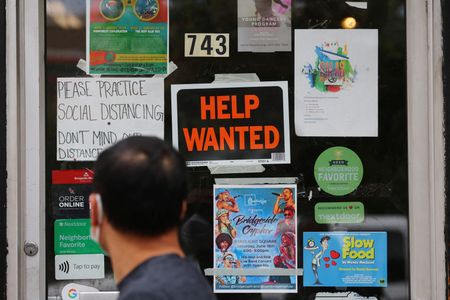By Lucia Mutikani
WASHINGTON (Reuters) – U.S. job openings unexpectedly rose in September, suggesting demand for labor remained strong, tempering financial market expectations that the Federal Reserve would dial back its aggressive interest rate increases in December.
With 1.9 job openings for every unemployed worker at the end of September, wage growth could remain elevated. But the Fed’s fight against inflation received a big boost from an Institute for Supply Management survey on Tuesday showing raw materials prices fell for the first time in 28 months in October. Supplier deliveries performance was the best since 2009.
The reports were published as Fed officials gathered for a two-day policy meeting. The U.S. central bank is expected to deliver another three-quarters of a percentage point rate hike on Wednesday as it fights to cool demand for labor and the overall economy to bring inflation down to its 2% target.
“The good news of more job openings for everyone will be bad news for everyone if Fed officials become convinced they need to push interest rates even higher and faster than before,” said Christopher Rupkey, chief economist at FWDBONDS in New York. “It is a head scratcher where you have to wonder whether 10 million job openings can stop a recession from coming.”
Job openings, a measure of labor demand, increased 437,000 to 10.7 million on the last day of September, the Labor Department said in its monthly Job Openings and Labor Turnover Survey, or JOLTS report, partially reversing August’s decline.
Economists polled by Reuters had forecast 10.0 million vacancies. The jobs-workers gap rose 0.4 percentage point to 2.6% of the labor force or 4.9 million workers.
There were 215,000 more job openings in the accommodation and food services industries, where employment remains below pre-pandemic levels.
Vacancies in healthcare and social assistance increased by 115,000, while the transportation, warehousing and utilities sector reported an additional 111,000 unfilled jobs.
But job openings decreased by 104,000 in wholesale trade. There were 83,000 fewer vacancies in the finance and insurance industry, likely reflecting a downturn in the housing market as higher borrowing costs stifle demand.
The job openings rate increased to 6.5% from 6.3% in August. It was 0.8 percentage point below its peak in March. Job openings increased in all four regions.
Hiring fell to 6.1 million from 6.3 million in August. Hiring decreased by 57,000 in the durable goods manufacturing industry and fell by 40,000 in state and local government education. (Graphic: JOLTS, https://graphics.reuters.com/USA-STOCKS/mypmomqnjpr/jolts.png)
About 4.1 million workers voluntarily quit their jobs, down from 4.2 million in August. Resignations fell by 56,000 in construction. There were also notable decreases in transportation, warehousing and utilities as well as durable goods manufacturing.
The quits rate, viewed by policymakers and economists as a measure of job market confidence, was unchanged at 2.7%, and has not dropped below this level since May 2021.
Layoffs dropped 162,000 to 1.3 million. That was the largest monthly decrease since January 2021 amid significant declines in industries like professional and business services as well as leisure and hospitality. This was further confirmation that employers were not willing to let go of their workers.
First-time applications for unemployment benefits have remained significantly low even as the Fed’s hefty rate hikes have increased the risk of a recession next year.
The Fed has raised its benchmark overnight interest rate from near zero in March to the current range of 3.00% to 3.25%, the swiftest pace of policy tightening in a generation or more.
Financial markets have been betting that the Fed would shift to a half-point rate hike at the December policy meeting. On Tuesday, they saw an better-than-even odds of a 75 basis points rate increase, according to the CME FedWatch Tool.
“We continue to expect a downshift to a 50 basis points hike in December, but resilient data raises further the risk that any slowdown is paired with hawkish communication that policy rates could rise for longer and eventually reach higher levels that are then sustained,” said Andrew Hollenhorst, chief economist at Citigroup in New York.
Stocks on Wall Street fell. The dollar rose against a basket of currencies. U.S. Treasury prices were mixed.
RAW MATERIAL PRICES FALL
But there were some glimmers of hope in the inflation fight.
In a separate report on Tuesday, the Institute for Supply Management said its measure of prices paid by manufacturers dropped to 46.6, the lowest reading since May 2020, from 51.7 in September. This price gauge has tumbled by 40.5 percentage points over the past seven months amid easing supply chain bottlenecks and commodity prices.
The ISM’s measure of supplier deliveries dropped to 46.8 last month, falling below the 50 threshold for the first time since February 2016, from 52.4 in September. A reading below 50 indicates faster deliveries to factories. It was the best monthly supplier deliveries performance since March 2009. (Graphic: ISM manufacturing PMI, https://graphics.reuters.com/USA-STOCKS/mopakmbnbpa/ism.png)
The ISM’s overall manufacturing PMI fell to 50.2 in October from 50.9 in September. A reading above 50 signals expansion in manufacturing, which accounts for 11.3% of the U.S. economy. Economists had forecast the index falling to 50.0.
Manufacturers reported “flat business activity” as well as “customers are canceling some orders,” and orders slowing “substantially.” There were also reports of a “general pullback in available capital budgets” by customers.
But even with raw material prices falling and demand for goods slowing, manufacturing is only a small part of the economy, meaning that the inflation fight will remain a long slog.
“This is a limited part of the story, however,” said Will Compernolle, a senior economist at FHN Financial in New York. “Inflation pressures have now shifted to the service sector as wage pressures and higher services spending by consumers have alleviated pressures from the goods side of the economy.”
(Reporting by Lucia Mutikani; Additional reporting by Lindsay Dunsmuir; Editing by Andrea Ricci)

